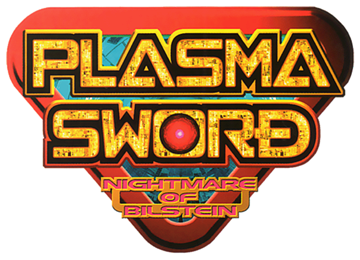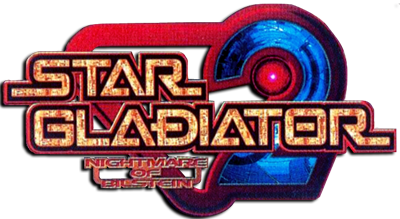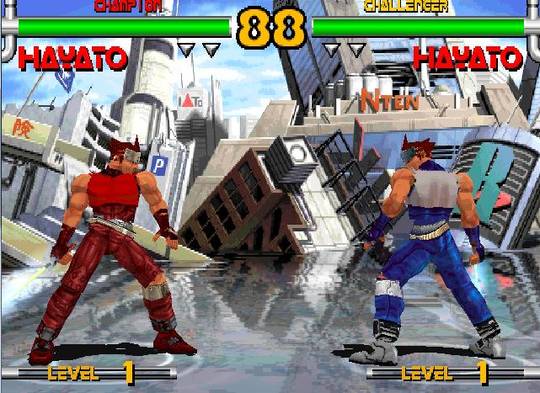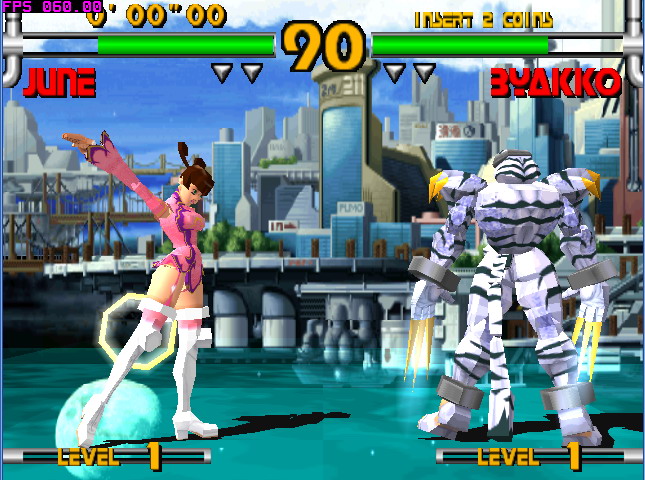Plasma
Sword / Star Gladiator 2
 
STORY:
In the epic battle of the Final Crusade that
occurred from last year, Hayato Kanzaki had slayed the evil Dr. Edward Bilstein
and brought the end of the Fourth Empire's terror and destruction throughout
the entire galaxy. The fall of the Fourth Empire and the death of its leader
were momentous occasions of last year and it signaled the restoration of peace
and happiness, but all is not well in the galaxy. Rumors have been circulating about the
unexpected return of Bilstein in a new cybernetic body, as well as the
appearance of a ghost who eerily looks like Bilstein's old cybernetic body. At
the same time, the Fourth Empire has taken the opportunity in rebuilding its
forces and the loyal members of the organization are determined to carry out
Bilstein's will of eliminating those that stand in the way of their master's
galaxy conquest.
Hayato, June, Saturn, and Gamof realize that
the threat of Bilstein is far from over and that the four of them must head back
into combat in order to defeat Bilstein and the Fourth Empire once and for all.
However, the quartet is not alone in their second struggle as they have new
friends to assist them in the matter, including the strong war soldier Gantetsu;
former enemy turned ally Zelkin; the aspiring hero Eagle; and a mysterious young
girl named Ele. Hayato and his friends will find themselves heading back into
the hard ordeal as Star Gladiators, Fourth Empire members, and neutral parties
will be thrust into a war that will determine the fate of not only the Earth,
but the entire galaxy. The Nightmare of Bilstein has now begun...
|

|
|
Plasma
Sword character selection screen.
|
REVIEW:
Plasma
Sword: Nightmare of Bilstein (known as Star Gladiator: Nightmare of Bilstein or Star Gladiator 2 in Japan) is the sequel to Star Gladiator,
one of Capcom's first ventures into the 3D
fighting game genre. The prequel released on Namco's System
11 Arcade Board and then ported to the Sony PlayStation. Plasma Sword
released on Namco's updated and improved System 12 Arcade board and was later ported to the Sega
Dreamcast in the year 2000.
Plasma Sword
features much faster gameplay than the prequel. A 3D fighting game to Capcom's
Rival Schools: United By Fate, Plasma Sword now only has polygonal characters but features a sidestep technique allowing characters to dodge projectiles and super moves. The game features 4-button layout, 2 buttons for weapon attack,
1 for kick, and 1 for guard. Unique to the series, characters can perform a damaging skill called
a Plasma Field. With the use of one super meter, the character who activates it
will emit a sphere of energy. If the move connects, the
playing field will be temporarily boxed in by four invisible walls, making escape
from the Plasma Field effects difficult. The effects of the skill vary with each
character, ranging to infinite Plasma Strikes, their weapons growing to gigantic sizes, and
even stopping time. If a character raises their Super Gauge to level 3, they can
then perform super moves called Plasma Strikes.
|

|
|
FUN
FACT: Hayato
also has those colors in MVC2!
|
All characters from the original Star Gladiator make their return in Plasma Sword, with
the exception of Rimgal and Kappah (two pretty entertaining characters, mind you). A total of 14 newcomers join the veteran roster of Star Gladiator, each with his or her own unique storyline that seem fitting for the Star Wars-inspired universe of the game. Sadly, many of the newcomers can easily be labeled as "palette swaps," since
they share the exact same fighting styles, animations, special moves and Plasma Fields of the the
original cast... but they do have their own unique Plasma Strikes.
Plasma Sword's Arcade Mode features 8 stages. Players will encounter a
mid-boss at Stage 5 which advances the story of their chosen character. At the
final stage, players face a specific final boss depending on their character. Additionally, players will either see a false ending or true ending
of the character depending on how many Battle Ability points they've obtained.
If a player obtains the required amount of Battle Ability points, they'll fight
another opponent (the "true" final boss) and can view a character's true ending.
|

|
|
A
far cry from
Soulcalibur on Dreamcast.
|
Visually, Plasma Sword is a small improvement over the Arcade / PS1-era original. Character models are sharper and more detailed,
but the stages are actually flatter and less "3D-looking" than the
prequel's. In my opinion, the background environments are quite bland and uninspired... consisting of an unimpressive 2D background image and rotating 3D
floor (a visual effect that definitely looked aged in the year 1999-2000). Animation-wise, the game lacks fluidity and the majority of animations of the game are quite janky, sadly. A few combos, mannerisms, and super moves look "cool-ish"... but many animations fall flat (because they literally don't seem like the characters are balanced at all). The cool "Capcom style"
2D character illustrations that appear in-game are, sadly, the best-looking part of the entire game.
Overall, Plasma Sword definitely falls very short in comparison to other fighting game releases on Dreamcast and in modern times. Seeing this game in motion next to the likes of
SoulCalibur (Dreamcast) and
Marvel Vs. Capcom 2 is like night and day. Since I mentioned MVC2, take a look at Hayato's animations in that game. His MVC2 animations simply embarrass Hayato's jittery, wonky Plasma Sword animations and key frames. Capcom tried, but their 3D animation team couldn't make the magic happen at
the end of the day. Try to take some notes from Namco, guys...
 FUN FACT:
Several Star Gladiator / Plasma Sword characters make appearances in other Capcom fighting games as both playable
characters and background / cameo characters. Protagonist Hayato Kanzaki appears as a playable character in
Marvel Vs. Capcom 2. Hayato's win
pose in MVC2 features several Plasma Sword character cameos.
FUN FACT:
Several Star Gladiator / Plasma Sword characters make appearances in other Capcom fighting games as both playable
characters and background / cameo characters. Protagonist Hayato Kanzaki appears as a playable character in
Marvel Vs. Capcom 2. Hayato's win
pose in MVC2 features several Plasma Sword character cameos.
|
|

| Page Updated: |
December
12th, 2024 |
| Developer(s): |
Capcom |
| Publisher(s): |
Capcom |
| Designer(s): |
Satsuma
Ikeda Director
Takayoshi Terada
Director
Hiro
Lead Programmer
Shoei
Title Design |
| Artwork
by: |
Bengus, Daichan, MCF,
Inoda Keigo
|
| Platform(s): |
Arcade,
Dreamcast
|
| Release Date(s): |
1999
Arcade
2000
Dreamcast |
| Characters: |
Hayato Kanzaki,
B.
Hayato,
June Lin Milliam, Ele,
Rain, Bilstein, Blood,
Byakko,
Gamof,
Gerelt,
Gore,
G.
Bilstein, Zelkin,
Vector,
Saturn, Prince, Omega,
Luca, Eagle,
Shaker,
Gantetsu,
Claire, Kaede,
Rai-on
|
|
|
|
Featured Video:
|
|
|
| Related Games: |
Star
Gladiator,
Rival Schools: United By Fate, Marvel
Vs. Capcom 2, Capcom Fighting Collection 2, Star Wars: Masters of Teras Kasi,
Project Justice, Street Fighter EX, Street
Fighter EX2, Street Fighter EX3,
Bloody Roar 2, Ehrgeiz:
God Bless the Ring, Final Fight Revenge, Fatal
Fury: Wild Ambition, Soul Calibur, Tekken
Tag Tournament,
Mortal Kombat Gold,
Power Stone,
Power Stone 2,
Last Bronx, Galaxy Fight |
|

|
|
Gameplay
Engine
|
6.5 / 10
|
|
Story
/ Theme
|
7.0 / 10
|
|
Overall
Graphics
|
6.0 / 10
|
|
Animation
|
5.0 / 10
|
|
Music
/ Sound Effects
|
6.0 / 10
|
|
Innovation
|
6.0 / 10
|
|
Art Direction
|
8.5 / 10
|
|
Customization
|
5.0 / 10
|
|
Options / Extras
|
5.0 / 10
|
|
Intro / Presentation
|
6.5 / 10
|
|
Replayability / Fun
|
5.0 / 10
|
|
"Ouch" Factor
|
5.5 / 10
|
|
Characters
|
6.5 / 10
|
|
BOTTOM LINE
|
6.5
/
10
|
|
Review based on Dreamcast
version
|
|
| Final
Words: |
Like the original Star Gladiator on PS1, Plasma Sword was an ambitious title by Capcom and perhaps very ahead of its time, conceptually. While the charismatic characters and futuristic theme has plenty of charm (and Star Wars references), Plasma Sword as a 3D fighting game short when compared to many
other fighting games from the era —
especially on Dreamcast.
Plasma Sword's gameplay is easy to get into, but very clunky - as are the animations. The game flows similarly to Rival Schools, with characters able to sidestep projectiles and super moves... but in general the game feels slow and sluggish (and looks the part, too).
If you give the full character roster a chance, certain movesets and match-ups can be fun. Plasma Sword's vibrant art direction definitely shines a positive light on the sci-fi character
designs, and they're definitely some of Capcom's most obscure and interesting in recent years. However, a fighting game can't live on a concept or a gimmick alone. Rival Schools, for example, is actually fun to play. If you ask me, Plasma Sword doesn't have the replayability of other recent 2D / 3D fighters.
Sadly, the in-game character models are still
looking pretty blocky-looking on Dreamcast, and the boring / flat 3D stages don't compliment the game's visuals, either. The Dreamcast was capable of far more impressive graphics at the time (just look at SoulCalibur, for one). In particular, if you picked up SoulCalibur at the Dreamcast launch like I did... it's quite difficult NOT to be disappointed by how Plasma
Sword looks and performs. However, it was a bit more impressive than Mortal Kombat Gold... even though that's not saying much. 
If anything, Plasma Sword seems mysteriously "unfinished". There is passion found in certain areas of the game design, but the execution and vision was lost in the translation into 3D. It just didn't work. If Capcom took their time and put another year or so into the game, maybe it could've shined with its unique designs and character play-styles. At the least, Plasma Sword
offers a charmingly different and
"original" theme in
the fighting genre. Seeing Capcom's take on Star Wars-inspired characters might be worth the price of admission alone... but beware, this game doesn't play anywhere near as good as Rival Schools, MVC2, SoulCalibur, or TEKKEN.
~TFG
Webmaster | @Fighters_Gen
|
|
|
|
|
|
|
|
|
|
|